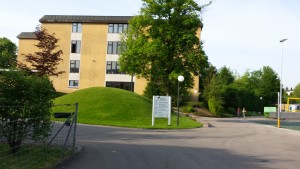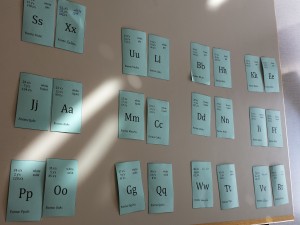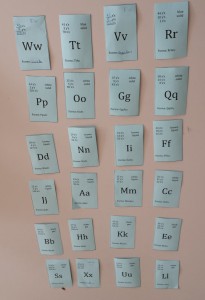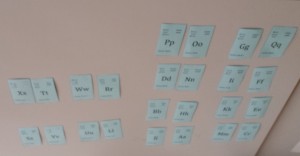May 4th to 8th

It being my first day in a school in Switzerland, and the students’ first day back from Spring Break, my sponsor teacher, Urs and I thought it best that I spend the day observing and acclimatizing. The school I am placed at is called Sekundarschule Ennetgraben (Ennetgraben Secondary School), located in the town of Affoltern am Albis. The school system in Switzerland varies greatly from ours in Canada. At the secondary school level here, there are 3 grade levels – 7, 8 and 9. Urs is a language and history teacher, and works part time. His teaching partner, Walther, teaches math and science for the rest of the lessons. Urs and Walther have the same set of 29 grade 8 students for the whole school year, unlike secondary teachers in Canada who have a different class for every lesson. Urs teaches these students English, German, French, and History, and Walther teaches them Math, Chemistry, Physics and Geography. Classes here are 45 minutes long, and the pupils (as students are called in Switzerland) have 7 to 8 lessons a day, and about 33 lessons a week. The normal school day begins at 7.35 am and ends at 5.10 pm.
One thing I found very interesting is that students here do not necessarily have to go on to further education after grade 9. Grade 8 onwards, they are encouraged to start thinking of their careers, and are encouraged to find apprenticeship positions in a field or career of their choice. Thus, during the spring break, a lot of the students were volunteering their time learning a new trade. I introduced myself briefly on the first day, and Urs asked the students to introduce themselves by saying their first names, what they did during their spring break in terms of apprenticeships, and their hobby. There were students who worked as apprentices of car mechanics, opticians, pharmacists, accountants, childcare or senior home assistants, etc. to name a few. The students find such opportunities throughout the year and can keep trying out as many as they need to find what interests them most. For students who do want to study further, there is a college, or gymnasium, as they call it. Students can then go on to work, or to university; or can also attend an equivalent of this gymnasium part time while working. This emphasis on career planning and job applications this early on is not as common in North America.
Overall this week, I taught six individual lessons in English and team taught two lessons in French with Urs. Four of these six lessons were English lessons for Urs, and the other two were Chemistry lessons for Walther. Each of these was a memorable experience. I was asked to make an autobiographical presentation that explained my life journey from Tanzania to India to Canada, and why I decided to come to Zürich. Although a bit nervous at first, it got easier to keep talking and share bits of my life and connection to the three different countries with the students, who also asked good questions and answered a few along the way. I ensured that they learned something about the culture, food, people and/or economy of these places during this presentation. Given that English is a foreign language for them, I was considerate about talking slower and using simpler words – and they were good about asking for clarification in case they did not understand me. With all the English classes I taught these students, I was impressed with their proficiency and their efforts in trying to express their thoughts and opinions, and I understood the difficulty with which they were doing so. Since it was my first time teaching ESL, I learnt that they need more scaffolding to be able to safely express their opinions, for example pre teaching the vocabulary and grammar to be used for an activity, or even listing it down on the board/projector before the start of the activity; providing sentence starters so they know how to express their thoughts, for example, “I agree because …”, “I disagree because …”, “I think ‘a’ is better than ‘b’ because of …”, etc.

What was more challenging than teaching an English lesson to non-native speakers of English, was teaching them Chemistry in English. German being the language of instruction, the students were not used to terms like the “Periodic Table” in English – but that did not mean that they did not know what the periodic table was. I had planned an activity where the students would work in groups and would be given a set of fictional element cards and their task would be to arrange the cards to make their own periodic table and to identify patterns in their table. At first I did not know how to begin, since we would not easily understand each other – so I showed them the periodic table and asked them to explain to me in their own words (in English) what it was and what information it had. Using their explanation and words, I gave them the instructions for the task, and was thrilled to discover that they understood what they were supposed to do.

Although struggling to find a way to begin arranging their cards, all groups managed to have a convincing table using their fictional elements by the end of the lesson. I then asked each group to explain to the rest how and why they arranged theirs in that particular way, and what patterns they noticed in the properties of the elements. The students could then see how differently the cards can be arranged with the same properties, depending on the order in which each characteristic is given priority. I learned that although difficult at first to communicate the scientific information in English, when the students are involved in doing a task and are able to explain the science behind it in their own words, it gets easier to judge their understanding and follow up with hints or further explanations.

When I look back at this week and look at the bigger picture, I realized that spending the first week with CW at the LSS and in her ELL classes was the perfect opportunity for me to begin learning about the needs of ELL. Not only did it give me the chance to interact with students whose first language is not English, it also was an important stepping-stone for me to get some practice in language training. This week I noticed myself slow down when giving instructions, gave simpler instructions, maintained eye contact with and directly addressed groups of students, and also learned to express myself in different ways. I even enlisted the help of a student who understood a word to translate or explain it to others who did not.
More on Week 3…